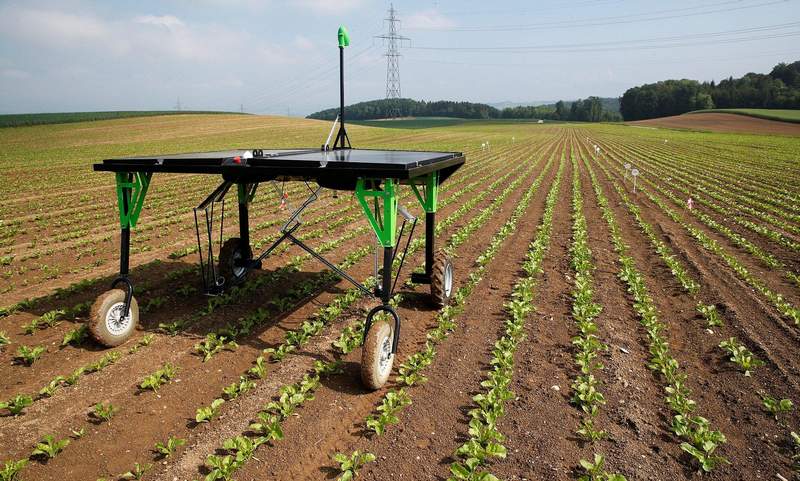Agriculture has been the cornerstone of human civilization from the moment man decided to live in communities. The transition from hunting and gathering to farming marked the turning point for mankind. Since then, we have been improving how we grow our own food, and as the population increases, we are now faced with new challenges.

Technology has allowed people to come up with better ways of farming. Ways that minimize input and maximize outputs. At the center of these innovations are robots, and the following are areas where they are applied in agriculture.
Crop Harvesting
The combine harvester can be viewed as the blueprint upon which robots used in harvesting crops are based on. Traditional methods of harvesting were tedious and involved a lot of human labor. Labor that needed to be fed and paid at the end of the day. That is no longer the case. Now, most of the heavy lifting is done by intelligent machines.
Berry 5 is a robot created by Harvest CROO that is used to pick berries on farms. It is fast enough to pick a berry plant clean in 8 seconds. It takes less than a minute to move to the next one.
Weeding

Before weed-killing chemicals were invented, weeding used to involve the tedious work of physically uprooting them. This could take days, and it needed a lot of hands-on board. As weeds became more resistant to these chemicals, new solutions had to be created. Weed management robots are now operational in some parts of the world.
Weeding robots use Artificial Intelligence technology to tell crops and weeds apart, stripping off weeds and leaving crops untouched. On top of this, they collect soil and weather data in the process to help the farmer monitor all conditions in real-time.
Robotic Greenhouses

Automation of greenhouses is another area that is making heavy use of robots. Greenhouses work best when the conditions inside are not disturbed. To optimize these conditions, it is better to have AI robots in there than humans.
Another advantage of using robots to farm greenhouses, they can man the largest spaces without getting tired. One example of a robot involved in this sector is the Iron Ox that is based in San Carlos, California.
Thinning and Pruning
Thinning and pruning is a delicate affair that is usually left for the most experienced experts on the farm. It has to be done right for the crop to have any chance of yielding results. With that in mind, it is quite remarkable that there are robots designed to handle this kind of complex activity.
LettuceBot is an example of a robot that is used to thin and prune lettuce plants. It employs a computer vision program that moves through the plants, deciding what to remove and what to keep.
Seed Planting Using Drones

Drones have proved, with time, how valuable and versatile they can be in the modern world. From military applications to handling deliveries and now, farming. Aerial imagery has always been confined to rich farmers who could afford to put a chopper in the air for long. Now, all you need is a drone to capture all that. You can use that data to plan irrigation layouts, determine the extent of weed growths, and so many other important factors.
With accurate AI programming, drones can be used to spread seeds on an expansive piece of land with immaculate precision. One particular drone that is making waves in the world is Taranis, an Israeli made farming drone.
Fertilizing and Irrigation
Irrigation and fertilizing are two activities that have always been administered in a blanket manner. Traditionally, there is no way of knowing which part of the farm needs more water or fertilizer. Farmers would simply distribute the two evenly, leading to unnecessary wastage.
Robots, on the other hand, are able to assess the land to give precise information on where more water or fertilizer is needed. This way, farmers will be able to avoid overusing water in some parts and starving in other areas.
Rowbot, for instance, moves between crops depositing fertilizer in the right amount that each plant needs.
The Pros and Cons of Using Agrobotics
Pros
- Robots do not get fatigued or sick; neither do they suffer injury. There is no need for time off.
- They are faster and more accurate compared to humans.
- With no need for salaries, they lower the cost of production while maximizing the profits in the long run.
- They come in varying sizes, depending on the function needed. You get exactly what you need for your farm.
- They can handle multiple functions in one move. They can weed, fertilize, and spray bugs at once.
Cons
- They cost a lot of money to set up or purchase for the farm. It takes a lot of funding to come up with one. It is therefore not a surprise that they cost an arm and a leg.
- They need constant maintenance for them to run at optimum levels. This requires dedicated experts to monitor them round the clock. That costs money and time.
- Their spare parts are just as costly as the whole unit itself. Most are not even found in the market, you will need to custom order them, and this could take time.
- They lead to farm layoffs by replacing human labor. A single robot can handle work meant for ten people at once.
Conclusion
There is no denying the disruption that has been caused by technology to our modern world. Sooner or later, everything will be in the hands of robots. If you are a farmer, start planning for that future by laying the groundwork now. It would be best if you start familiarizing yourself with all the new farming technologies, including robots, early enough.
If you have any questions regarding robots and how they work, simply visit evsint.com and you will get all the help you need.

